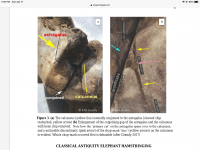I've been reading Gramly's new book. "The Bowser Road Mastodon..." Gramly says the way Africans kill elephants is by first disabling them with an axe chop to the Achilles tendon. Once cut, the elephant can't walk and can be dispatched with spears.
So where would a paleo Indian get an axe? Gramly's theory is that they hafted a platter biface edgewise in a branch and used it as an axe to cut the tendon.
I'm not sure what to think about it. He's definitely thinking outside the box. Gary
So where would a paleo Indian get an axe? Gramly's theory is that they hafted a platter biface edgewise in a branch and used it as an axe to cut the tendon.
I'm not sure what to think about it. He's definitely thinking outside the box. Gary
Upvote
0







